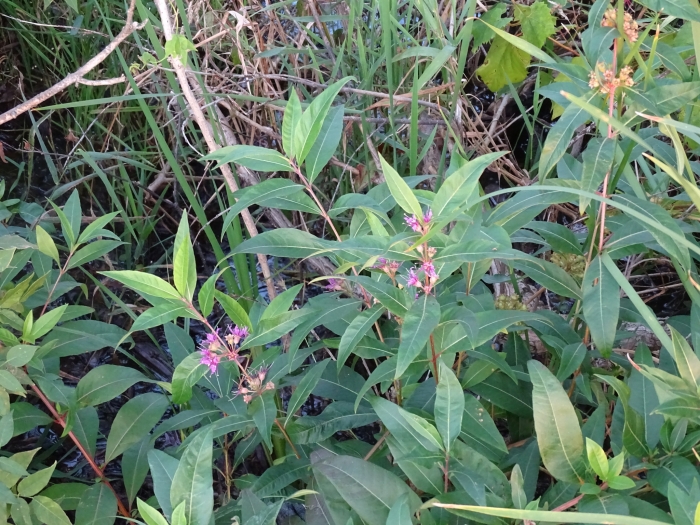Swamp Loosestrife
(Decodon verticillatus)
Swamp Loosestrife (Decodon verticillatus)
/
/

Reuven Martin
Public Domain
Image By:
Reuven Martin
Recorded By:
Copyright:
Public Domain
Copyright Notice:
Photo by: Reuven Martin | License Type: Public Domain | License URL: http://creativecommons.org/publicdomain/zero/1.0/ | Rights Holder: Reuven Martin | Publisher: iNaturalist | Date Created: 2020-09-11T18:29:48-07:00 |

















































Estimated Native Range
Summary
Decodon verticillatus, commonly known as Swamp Loosestrife, is a clump-forming shrubby perennial native to freshwater wetlands, including swamps, marshes, and the edges of ponds and lakes in Eastern North America. It is not related to the invasive Purple Loosestrife. Decodon verticillatus typically grows up to eight feet (2.4 m) tall with arching, angular stems that are smooth and woody near the base. These stems can root at the tips when they bow over and touch the mud, allowing the plant to spread. The rose-pink flowers, which are under one inch (25 mm) wide with usually five petals narrowing at the base, grow in axillary clusters and bloom in June and July. The fruit is a spherical dark brown capsule containing numerous reddish seeds.
Swamp Loosestrife is valued for its ornamental qualities, particularly its attractive flowers and growth habit. It is often used in water gardens, naturalized pond edges, and wetland restoration projects. This plant thrives in full sun to part shade and requires high amounts of water, tolerating a range of soil drainage conditions from fast to slow. It is relatively low maintenance but should be monitored to prevent unwanted spread in smaller water features. Swamp Loosestrife is not commonly afflicted by diseases or pests, making it a resilient choice for suitable wetland areas.CC BY-SA 4.0
Swamp Loosestrife is valued for its ornamental qualities, particularly its attractive flowers and growth habit. It is often used in water gardens, naturalized pond edges, and wetland restoration projects. This plant thrives in full sun to part shade and requires high amounts of water, tolerating a range of soil drainage conditions from fast to slow. It is relatively low maintenance but should be monitored to prevent unwanted spread in smaller water features. Swamp Loosestrife is not commonly afflicted by diseases or pests, making it a resilient choice for suitable wetland areas.CC BY-SA 4.0
Plant Description
- Plant Type: Subshrub, Shrub
- Height: 6-8 feet
- Width: 6-8 feet
- Growth Rate: Rapid
- Flower Color: Pink, Purple
- Flowering Season: Summer
- Leaf Retention: Deciduous
Growth Requirements
- Sun: Full Sun, Part Shade
- Water: High
- Drainage: Fast, Medium, Slow
Common Uses
Bird Garden, Butterfly Garden, Hummingbird Garden, Showy Flowers, Water Garden
Natural Habitat
Freshwater wetlands, including swamps, marshes, and the edges of ponds and lakes in Eastern North America
Other Names
Common Names: Water Willow, Water-Willow, Swamp-Loosestrife
Scientific Names: , Decodon verticillatus, Decodon verticillatus var. laevigatus, Nesaea verticillata, Lythrum verticillatum, Decodon verticillatus var. verticillatus, Decodon aquaticus, Decodon verticillatus var. pubescens,
GBIF Accepted Name: Decodon verticillatus (L.) Elliott